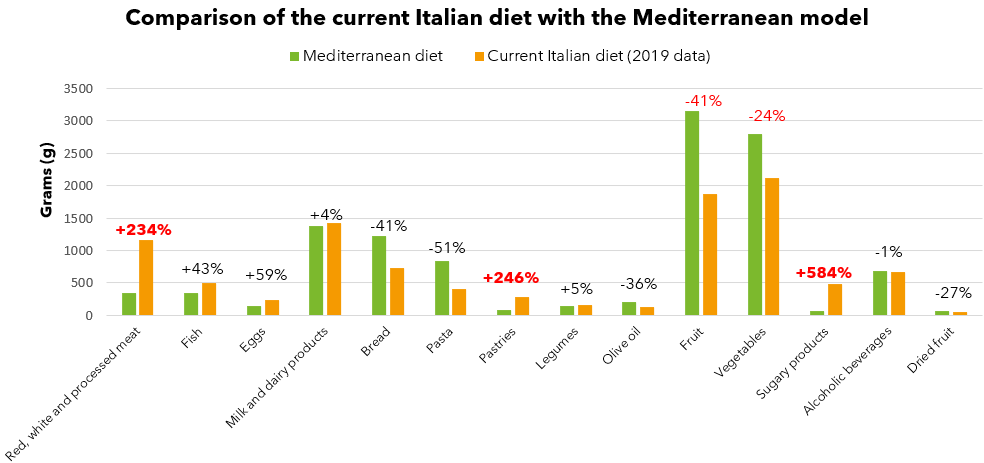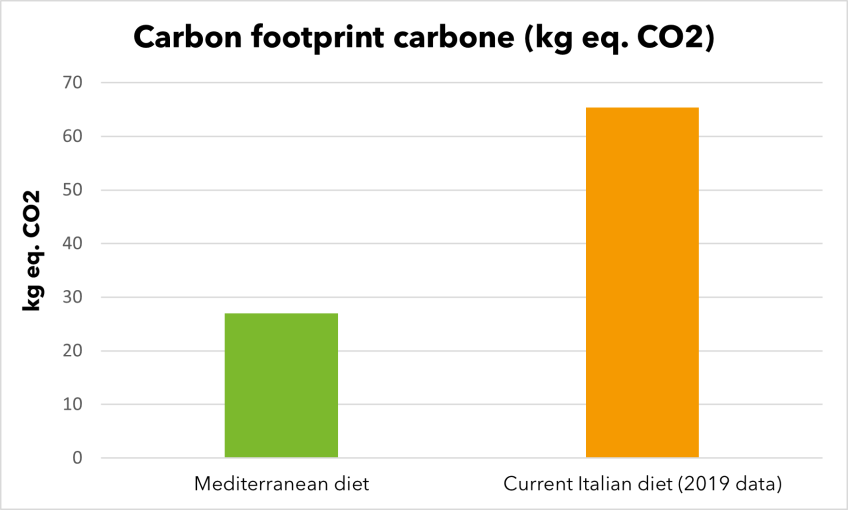
Food systems are responsible for more than one third of global greenhouse gas emissions (FAO, 2021). One week after World Climate Day, Aprifel reviews a recent Italian study that evaluated the impacts of the current Italian diet on the environment. This work shows that Italians are progressively moving away from the traditional Mediterranean diet and thus have a less sustainable diet. This study suggests that we need to change our food systems to benefit health, the environment and the fight against climate change.
Mediterranean diet is recognized for its health benefits, but also for its environmental and social effects (Castaldi, 2022). However, many countries in the Mediterranean area are gradually abandoning the principles of the Mediterranean diet in favor of a Westernized diet – including increased consumption of meat and sugary products, along with a reduction in the fruits and vegetables, cereals, complex foods or legumes intakes (Vilarno, 2019). In this context, the study by Vinci et al, 2022 assessed the environmental impacts of Italians’ reduced adherence to the Mediterranean diet through life cycle assessment and a carbon footprint analysis (see methodology).
An excessive consumption of meat, pastries and sweet products
Traditionally linked to the Mediterranean diet, the Italian dietary patterns are moving away from the principles of this model. Thus, the work of Vinci et al. reveals that Italians consume an average of 3,503 kcal/person/day, which is +75% of the daily caloric intake recommended by the Mediterranean diet. These results can be explained by a significantly higher consumption of meat and meat products, pastries and sweet products.
of meat and meat products consumption
of pastry consumption
of sweet products consumption
Finally, current fruit and vegetable intakes are 41% and 24% below the recommendations of the Mediterranean diet, respectively (see figure below).

A greater impact on the environment
Based on this, the authors assessed the impacts of this shift from the Mediterranean diet through 3 categories of environmental impacts. To this end, a comparative life cycle assessment (see box) and a carbon footprint assessment were performed.
As a result of the high consumption of animal products, the current diet has a 133% greater impact on the environment than the Mediterranean diet. The most significant differences are related to:
- Land use: +145%.
- Marine eutrophication: +135%.
- Impact of global warming on land and freshwater ecosystems: +127%.
- Impact of water consumption on the aquatic ecosystem: +123%.
Regarding the carbon footprint, this study indicates that the eating habits of Italians generate a total carbon footprint +142% higher than the Mediterranean diet (see figure below).

Effects on the environment have an impact on health and the economy
Based on the previous analysis, authors also estimated the health and economic consequences of these environmental impacts.
Current Italian consumption contributes more (+100%) to environmental impacts affecting human health than the Mediterranean diet. Many of these impacts contribute to global warming and thus to the deterioration of living conditions (Trisos, 2020).
Finally, the contribution of the current diet to the scarcity of mineral and fossil resources – and therefore to the costs generated – is greater (+59%) than the Mediterranean model. According to this work, adopting the recommendations of the Mediterranean diet could save $53 of annual resources per person, or a total of $3.2 billion per year.
Improve diet sustainability and promote environmental compatibility from production to consumption
Given this observation, the authors insist on the need of improving the sustainability of diets and promoting environmental compatibility from production to consumption, according to the European strategy “From Farm to Fork“.
To promote this dietary transition, the authors recommend that policies should be inspired by the Mediterranean model. They also suggest that future work should take into account social impacts in order to assess the sustainability and quality of the diet in a holistic way.
Life cycle assessment is a global and multi-criteria evaluation method of the environmental impacts of a service or a product throughout its existence (from design to end-of-life management). It identifies and quantifies the energy and material flows associated with human activities and is therefore a robust tool for an eco-design approach. Principles, requirements and modalities of life cycle assessment are defined by the international standards ISO 14040 and ISO 14044 (ADEME, 2018).
- A life cycle assessment was used to evaluate the contribution of Italian food consumption in 2019 to different categories of environmental impacts compared to the Mediterranean diet recommendations. The impact categories were divided into 3 macro areas: environment, human health and economy.
- The following stages were considered in the analysis: production, industrial processing, manufacturing, transportation, packaging, retailing and consumption. Food waste disposal was not considered.
- Databases used: Agribalyse v3.0.1, Ecoinvent v3.8, and World Food LCA Database (WFLDB) v3.5.
- The chosen functional unit is 14,000 kcal, which is the recommended weekly caloric intake for an adult of normal weight whose daily needs amount to about 2,000 kcal/day.




